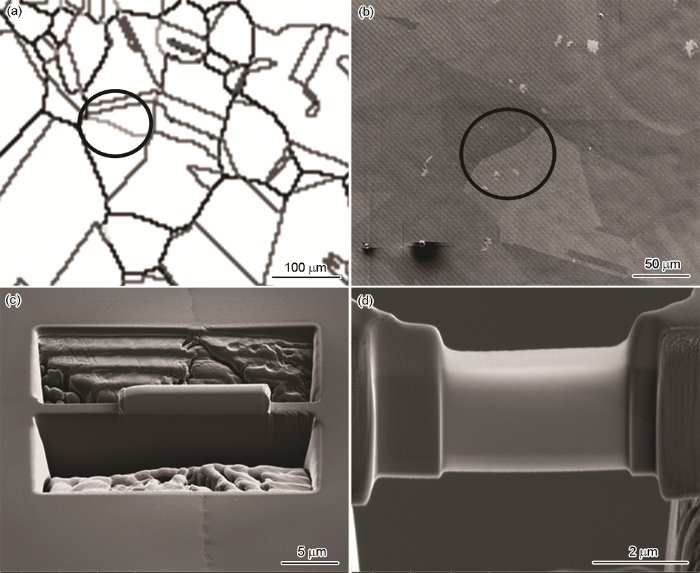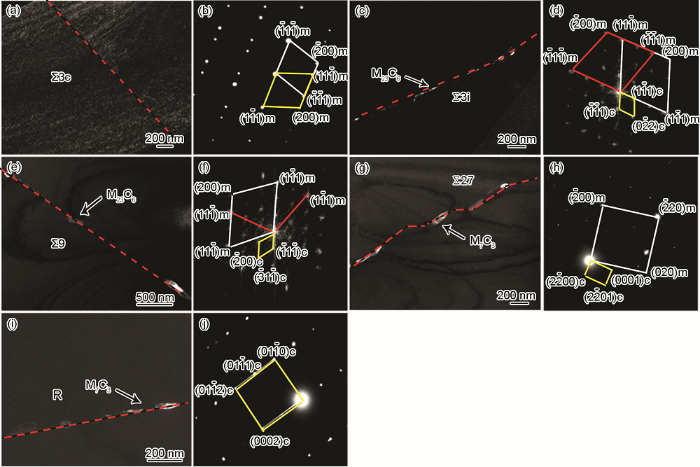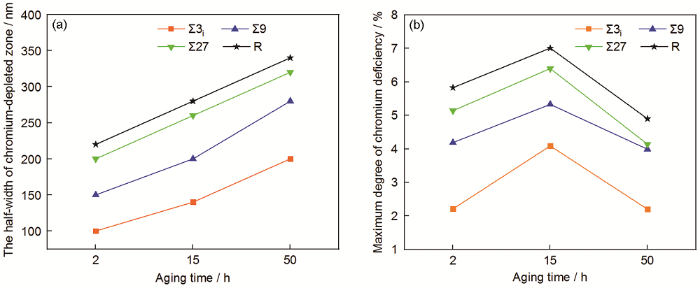Inconel 600合金(Ni-16Cr-9Fe,质量分数,%)是一种面心立方结构镍基耐蚀耐热合金,具有优异的耐腐蚀性能和综合力学性能,广泛用于制造压水堆核电站中的蒸汽发生器传热管[1]。蒸汽发生器传热管在服役中腐蚀破损的主要形式,是晶间腐蚀(Intergranular Attack,IGA)和晶间应力腐蚀(Intergranular Stress Corrosion Crack,IGSCC)[2]。碳化物析出引起晶界附近贫铬,是镍基高温合金和奥氏体不锈钢发生IGA和IGSCC的主要原因[3,4,5,6]。为了提高600合金的服役性能,有必要系统研究晶界处碳化物的析出形态和晶界附近铬浓度的分布。
在20世纪80年代Watanabe提出了晶界控制及设计的概念,后来发展为晶界工程(Grain Boundary Engineering,GBE)[7],其主要原理是通过适当的热机械过程增强低层错能面心立方金属中低Σ重合位置点阵(Coincidence Site Lattice,CSL)晶界的比例,进而提高材料与晶界相关的宏观性能。可以用GBE技术引入600合金中高比例的低ΣCSL晶界,提高其对IGA和IGSCC的抵抗力[8]。Telang等[9]发现,GBE处理使600合金中低ΣCSL晶界的比例显著提高,抗晶间腐蚀性能更好。Bi等[10]研究了碳化物析出引起的晶界附近的贫铬情况,发现低ΣCSL晶界附近的贫铬程度低于随机晶界的贫铬程度。Lim等[11]研究发现,690合金中碳化物在Σ≤29的低ΣCSL晶界处析出倾向小于随机晶界。其主要原因是低ΣCSL晶界的晶界能低,碳化物很少或很难在晶界上析出,从而降低了晶界附近的贫铬程度。李慧等[12]通过晶界工程提高600合金的低ΣCSL晶界比例,将GBE态样品在715℃时效不同时间后研究了不同类型晶界处析出碳化物的形貌特征及演化规律,发现晶界类型和时效时间对碳化物的析出有一定的影响。
但是,大部分文献侧重于研究晶界类型和时效时间对碳化物析出规律的影响。本文对600合金进行GBE和时效处理后确定晶界类型,并研究其对碳化物形貌和结构的影响以及碳化物的析出对晶界附近贫铬的影响。
1 实验方法
实验用 Inconel 600合金成分(质量分数,%)为Cr 15.280,Fe 8.040,Mn 0.150,Si 0.130,Cu 0.050,C 0.030,S 0.002,Ni余量。用线切割切取尺寸为10 mm×5 mm×0.8 mm的片状样品并将其密封在真空度为5×10-1 Pa的石英管中,在1100℃固溶15 min后水淬。将固溶处理后的样品冷轧5%,再密封在石英管中在1100℃再结晶退火5 min,然后水淬。将水淬后的再结晶退火样品在715℃时效不同时间。
将时效后的样品进行机械抛光、电解抛光和电解蚀刻以显示晶界处碳化物的形貌,抛光液为5% HClO4+95% C2H6O(体积分数),在0℃和30 V直流电压下抛光~35 s,然后在10 mL H2SO4+40 mL HCl+50 mL H2O+3 g CuSO4的腐蚀液中腐蚀样品2 s。用配备在CamScan Apollo 300热场发射SEM上的EBSD(Oxford Instruments/HKL)附件确定晶界两侧晶粒的取向关系,扫描步长为3 μm,扫描区域为1200 μm×1200 μm,利用HKL-Channel 5软件分析结果。用取向成像显微(Orientation Image Microscopy,OIM)系统确定晶界类型,根据Palumbo-Aust标准[13] 判定晶界类型,晶界两侧的取向差相对于标准CSL模型的最大偏差角为△θmax=15°Σ-5/6。确定晶界类型后,用FEI Helios 600i双束型聚焦离子束(Focus Ion Beam,FIB)切取各种类型晶界的TEM样品。用JEM 2100F HRTEM观察样品晶界处析出相的形貌并进行SAED分析。用JEM 2100F HRTEM配备的INCA EDS分析晶界附近的元素分布。
2 结果和讨论
图1给出了经过不同处理的600合金中不同类型晶界的OIM图和晶界特征分布统计图,其中OIM图中的Σ3晶界用红色表示,Σ9晶界用蓝色表示,Σ27晶界用绿色表示,其它类型低ΣCSL晶界用黄色表示,随机晶界用黑色表示(图1a,b)(本文其他OIM图中的晶界类型,都这样表示)。图1c给出了固溶态和GBE态样品中不同类型晶界比例的统计,1100℃固溶处理15 min的样品中退火孪晶形成的Σ3晶界较多,但是Σ9,Σ27等的低ΣCSL晶界很少(少于1%)(图1a,c)。经过GBE处理后在多重孪生过程中形成了许多被随机晶界包围的具有Σ3n取向关系的晶粒团簇,晶粒团簇内均为Σ3n晶界,其中Σ9和Σ27晶界显著增加到5%以上[14](图1b,c)。从图1c明显可见,GBE处理后的样品中总的低ΣCSL晶界的比例从54.47%增加到72.59%,而随机晶界的比例显著降低。
图1
图1
600合金样品在1100℃固溶处理15 min、固溶处理后冷轧5%、再在1100℃再结晶退火5 min(GBE)后的OIM图,以及固溶处理和GBE处理的样品中不同类型晶界特征分布统计图(Palumbo-Aust标准[13],长度百分比)
Fig.1
OIM maps of Alloy 600 samples (a) solution treated at 1100℃ for 15 min, (b) and then is cold-rolled 5%, recrystallized at 1100℃ for 5 min, and (c) grain boundary character distribution statistics (Palumbo-Aust criterion[13], length fraction) of solution treatment and GBE treated samples
图2
图2
用双束FIB技术制备含有特殊晶界的TEM样品
Fig.2
Preparing of TEM samples using focus ion beam technology. (a) OIM map of sample, (b) the corresponding SEM image of the Σ27 grain boundary indicated by the black circle in figure a, (c) cutting the slice containing this grain boundary, (d) milling to prepare the thin foil TEM sample containing this grain boundary
图3给出了600合金在715℃时效2 h后不同类型晶界处碳化物形貌的TEM暗场像和对应的SAED分析,Σ3c和Σ3i晶界分别代表Σ3晶界的共格界面和非共格界面。从图中可以看出,不同类型晶界处碳化物的形貌有较大的不同。这与文献[12]中的SEM照片600合金中不同类型晶界处析出的碳化物形貌相同,即同一晶界不同区段碳化物较小的差异并不影响晶界类型对碳化物析出形貌影响。图3b中的SAED图显示该晶界为孪晶界,具有绕<111>轴旋转60o的特定取向关系,且晶界为平直状,满足Σ3c晶界的取向与形貌特征[15],与制备TEM样品时所对应的OIM图的结果一致,证明用上述方法制备不同类型晶界的TEM样品的准确性。在该晶界处并未观察到碳化物析出(图3a,3b),因为Σ3c晶界能量较低,元素偏聚量较低,不能提供足够的元素使碳化物在较短的时效时间内形核并生长[16]。图3d中的SAED图表明,晶界两侧晶粒都具有绕<111>轴旋转60o的特定取向关系,满足Σ3i晶界形貌与取向特征,晶界处M23C6碳化物主要沿着晶界不规则生长(图3c),碳化物的晶格参数(ac~1.06 nm)约为基体(am~0.35 nm)的三倍,其与一侧基体存在(
图3
图3
在715℃时效2 h后不同类型晶界处析出碳化物的TEM暗场像和SAED分析图
Fig.3
TEM analysis of carbide precipitated at grain boundaries with various characters in the samples aging at 715℃ for 2 h (The dashed line highlights the position of grain boundary) (a, b) Σ3c grain boundary, (c, d) Σ3i grain boundary, (e, f) Σ9 grain boundary, (g, h) Σ27 grain boundary, (i, j) Random grain boundary
富铬碳化物在晶界的析出会引起晶界附近贫铬,从而产生贫铬区。随着时效时间的延长基体内距离晶界较远的Cr原子会向贫铬区扩散,使晶界附近贫铬的范围逐渐扩大[19]。晶界附近的贫铬情况,可以用贫铬区的半高宽和贫铬深度描述。贫铬区的半高宽即铬浓度曲线最低处深度为一半时曲线的全宽,贫铬深度用基体平均铬浓度与贫铬区的铬浓度之差表示。图4给出了600合金在715℃时效不同时间后不同类型晶界附近的铬浓度分布图,其中图4a给出了对晶界附近进行能谱线扫描的STEM示意图,黑色箭头代表能谱线扫描的位置。本文所有成分曲线,均用此法得到。图4b给出了合金715℃时效2 h后各晶界附近的铬浓度分布图。Σ3c晶界附近的铬浓度基本上与基体一致,没有出现贫铬现象。其原因是,碳化物的析出需要Cr原子通过晶界扩散和短程晶格扩散产生偏聚,而该晶界周围不容易发生偏聚[20],因此晶界附近的铬浓度没有变化。Cr和C等碳化物形成元素在非共格晶界容易出现偏聚,在晶界处析出较多的碳化物,因此在Σ3i晶界附近出现明显的贫铬区,此处贫铬区的半高宽为100 nm,贫铬最大深度为2.21%。在Σ9晶界析出的碳化物尺寸更大,附近的贫铬程度提高,贫铬区的半高宽为150 nm,贫铬最大深度为4.19%。在Σ27晶界处析出的碳化物比较粗大,引起的贫铬程度比较严重,贫铬区的半高宽为200 nm,贫铬的最大深度达到5.14%。随机晶界附近的贫铬现象最严重,附近的贫铬半高宽为220 nm,贫铬最大深度为5.83%。
图4
图4
在715℃时效不同时间后样品贫铬区的演化规律
Fig.4
Evolution of depletion zone in the samples aged at 715℃ for different time. (a) STEM image showing the position of EDS line scan near the grain boundary of the samples, and the distribution of chromium concentration at different types of grain boundaries in the samples aged at 715℃ for (b) 2 h, (c) 15 h, (d) 50 h
在715℃时效15 h后各类型晶界附近的铬浓度分布如图4c所示,可见Σ3c晶界附近的铬浓度基本上没有变化。Σ3i晶界附近的贫铬程度提高,贫铬区的半高宽增加至140 nm,贫铬最大深度增加至4.09%。其原因是,随着时效时间的延长晶界处碳化物的长大消耗了更多的Cr原子,使晶界附近的贫铬现象更严重。Σ9晶界附近贫铬区的半高宽增大到200 nm,最大深度为5.33%。Σ27晶界和随机晶界处两侧的贫铬程度都有相似程度的提高,其中Σ27晶界和随机晶界附近贫铬区的宽度分别为260 nm和280 nm,贫铬区最大深度分别为6.40%和7.01%。
图4d给出了合金在715℃时效50 h后各类型晶界附近的铬浓度分布图。可以看出,随着时效时间延长到50 h在Σ3c晶界附近也没有出现明显的贫铬。Σ3i晶界两侧的贫铬发生了明显的变化。随着碳化物向晶粒内进一步长大晶界附近贫铬区的半高宽明显增加到200 nm,而贫铬区最大深度却降低至2.20%。Σ9晶界附近的贫铬区的半高宽也明显增加到280 nm,贫铬区最大深度降低至3.99%;Σ27晶界和随机晶界附近的贫铬区半高宽分别增加至320 nm和340 nm,贫铬区的最大深度降低到4.14%和4.90%。
图5给出了600合金在715℃时效不同时间后不同类型晶界附近贫铬的演化规律。从图5可见,在相同时效条件下晶界的Σ值越高附近的贫铬越严重。但是,各晶界处贫铬区的半高宽随着时效时间的延长不同程度地增大(图5a),时效15 h后Σ27晶界和随机晶界附近贫铬半高宽的增加较快。其原因是,碳化物的平均尺寸与晶界附近的贫铬程度密切相关[21],而晶界处碳化物的析出与晶界特性和晶界元素的偏聚密切相关。晶界处原子的排列是不规则的,溶质和杂质原子容易在晶界处偏聚,从而使碳化物的成核和析出[22]。由于Σ27晶界和随机晶界处的M7C3碳化物的长大速度高于Σ3i和Σ9晶界处M23C6碳化物的长大速度,碳化物的析出消耗了较多的Cr原子,因此晶界附近贫铬区半高宽的增加较快。在时效50 h后的Σ3i和Σ9晶界附近贫铬区半高宽的增加速度较快,因为长时间时效的Σ3i和Σ9晶界处的M23C6碳化物比短时间时效的生长速度较快,碳化物与基体界面向基体迁移速度增加,从而使晶界附近的贫铬半高宽明显增加。
图5
图5
在715℃时效不同时间后600合金不同类型晶界附近的贫铬情况
Fig.5
Evolution of chromium depletion zone near grain boundaries with various characters in the samples aged at 715℃ for different time (a) the half high width and (b) the depth of chromium depletion zone
图5b给出了各类型晶界处的贫铬最大深度在时效15 h后达到最大值,但时效50 h后晶界附近的贫铬区深度显著降低。其主要原因是,600合金长时间时效后碳化物生长消耗较多的Cr原子,但Cr原子扩散到贫铬区使贫铬较严重的区域发生部分回复,使晶界附近的贫铬区深度降低。其中Σ27晶界和随机晶界处贫铬区深度的下降较快,因为Σ27晶界和随机晶界附近贫铬比较严重,贫铬区的铬浓度与基体铬浓度相差较大,使铬元素向贫铬区的扩散较快,使晶界处贫铬区深度的降低较快。
以上分析表明,Inconel 600合金在715℃时效后各晶界处碳化物的析出与晶界特性密切相关。不同类型晶界处碳化物的形貌和成分不同,因此晶界附近的贫铬情况也不同。随着时效时间的延长各晶界处碳化物的长大消耗了大量的Cr原子,使晶界处贫铬区的半高宽不同程度的增大,而基体内距离晶界较远的Cr原子向贫铬区扩散使贫铬的深度逐渐降低。这表明,可应用晶界工程处理调整样品的晶界特征分布以提高样品的耐晶间腐蚀性能。
3 结论
(1) 在715℃时效的Inconel 600合金,在不同类型晶界处碳化物的形貌和结构有较大的不同。在Σ3c晶界处没有碳化物析出,在Σ3i晶界处析出不规则形状的M23C6碳化物,在Σ9晶界处析出较大的M23C6碳化物颗粒,在Σ27晶界和随机晶界处析出粗大的M7C3碳化物颗粒。M7C3碳化物的长大速度,高于M23C6碳化物的长大速度。
(2) 晶界的Σ值越高,在其附近的贫铬越严重。Inconel 600合金在715℃时效过程中,随着时效时间的延长各类型晶界附近贫铬区的宽度有不同程度的提高,时效15 h的贫铬区深度最大,时效50 h后贫铬区的深度显著降低。
参考文献
Effects of hydrogen on stress corrosion crack growth rate of nickel alloys in high-temperature water
[J].
Predicting tube repair at French nuclear steam generators using statistical modeling
[J].
Analysis of the creep strength of a low-carbon AISI 304 steel with low-Σ grain boundaries
[J].
Effect of a heat treatment on the precipitation behavior and tensile properties of alloy 690 steam generator tubes
[J].
Structure, chemistry, and stress corrosion cracking of grain boundaries in alloys 600 and 690
[J].
Study on grain boundary carbides and chromium depletion near grain boundary in two kinds of 690 alloys with different N contents
[J].Nickel-based alloy Inconel 690 (hereinafter called alloy 690) is currently replacing alloy 600 as steam generator tubes in pressurized water nuclear reactors, owing to its excellent resistance to intergranular stress corrosion cracking (IGSCC) and good mechanical properties. The carbide precipitation is a major microstructural characteristic during heat treatment of stainless steels and nickel-based alloys. The carbide precipitation and chromium depletion in the grain boundary of alloy 690 were investigated. The grain size and carbide of alloy 690 with 0.001% and 0.03% (mass fraction) nitrogen contents were observed and analyzed. The extent of chromium depletion in the vicinity of grain boundaries was quantitatively determined as a function of thermal treatment time. The solution treatment of the samples was at 1080 ℃ for 10 min, and then the samples were thermally treated at 715 ℃ for 1~25 h. The results show that the nitrogen addition decreases the intergranular carbide density and the average carbide length but increases its distance. The level of chromium in the depleted regions in alloy 690 with 0.03%N is higher than that with 0.001%N. This is attributed to the beneficial role of nitrogen addition against grain growth and sensitization.
2种N含量不同的690合金中晶界碳化物及晶界Cr贫化研究
[J].针对2种N含量(0.001%和0.03%, 质量分数)的690合金, 采用SEM, TEM并结合EDS分析等手段系统研究了时效处理后合金晶界碳化物和晶界附近的Cr贫化行为, 并定量描述了热处理时间对晶界附近Cr贫化程度的影响. 结果表明, 高N含量合金晶界析出的碳化物之间距离较大, 且碳化物尺寸较小, 随着时效时间延长碳化物逐渐长大. 随着时效时间的延长, 贫Cr区的Cr含量逐渐提高, 高N含量的690合金晶界附近贫Cr区的Cr含量高于低N含量合金, 主要原因是晶粒细化所致.
An approach to grain boundary design of strong and ductile polycrystals
[J].
Interface control for resistance to intergranular cracking
[J].
Effect of thermo-mechanical processing on sensitization and corrosion in alloy 600 studied by SEM- and TEM-Based diffraction and orientation imaging techniques
[J].
Suppression of chromium depletion by grain boundary structural change during twin-induced grain boundary engineering of 304 stainless steel
[J].
The effect of grain boundary misorientation on the intergranular M23C6 carbide precipitation in thermally treated Alloy 690
[J].
Morphology evolution of grain boundary carbides in highly twinned inconel alloy 600
[J].
On a more restrictive geometric criterion for “special” CSL grain boundaries
[J].
Precipitation behavior of grain boundary M23C6 and its effect on tensile properties of Ni-Cr-W based superalloy
[J].
Evolution of carbide morphology precipitated at grain in boundaries Ni-based alloy 690
[J].low ∑coincidence site lattice (CSL) boundaries aged at 715 ℃ for 2---200 h were investigated by SEM. The results show that the sizes ofintergranular carbides decrease with ∑value decreasing, and only fine carbides at coherent ∑3 are almost not changed after aging for 200 h. Plate--like carbides precipitated near both incoherent ∑3 and ∑9 boundaries, and the carbide plates grow bigger with the aging time prolonging, in which the former precipitated near both sides of incoherent ∑3 boundary and the latter precipitated near only one side of ∑9 boundary. The morphology of carbide precipitated at ∑27 boundary is similar to that precipitated at the general high angle grain boundary, and no plate--like carbides are observed near these boundaries.]]>
镍基690合金时效过程中晶界碳化物的形貌演化
[J].用SEM研究了含有高比例低∑重位点阵 (CSL)晶界的镍基690合金在715℃时效过程中不同类型晶界上碳化物的形貌演化. 结果表明: 低∑CSL晶界与一般大角晶界上碳化物的形貌演化特征有明显区别.晶界上的碳化物粒子尺寸随∑值降低而减小, 共格∑3晶界上的小尺寸碳化物在长时间时效后无明显变化; 非共格∑3晶界和∑9晶界附近都观察到板条状碳化物, 并随时效时间延长明显长大, 非共 格∑3晶界两侧都存在碳化物板条, 而∑9晶界上的碳化物板条只在晶界一侧生长; ∑27晶界与一般大角晶界处的碳化物形貌相似, 在晶界附近未观察到板条状碳化物.
Grain-boundary structure and segregation behavior in a nickel-base stainless alloy
[J].
The role of Σ9 boundaries in grain boundary engineering
[J].
Stacking faults and superlattice observations during transmission electron microscopy of a (Fe,Cr)7C3 carbide
[J].
Evolutionary dynamics simulation and process optimization of 690 alloy grain boundary carbide and chromium-depleted zone
[J].
690合金晶界碳化物和贫铬区演化动力学模拟及工艺优化
[J].
Elements segregation and phase precipitation behavior at grain boundary in a Ni-Cr-W based superalloy
[J].
Investigation of carbide precipitation process and chromium depletion during thermal treatment of alloy 690
[J].










